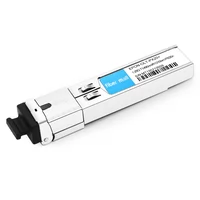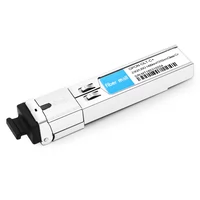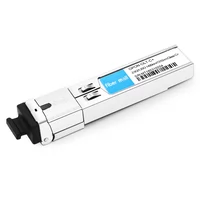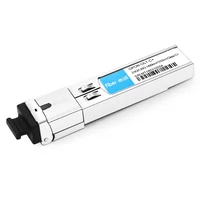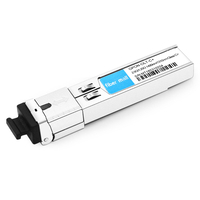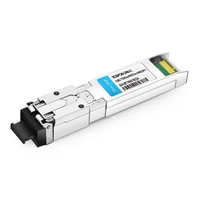Omdia’s latest forecast shows a significant growth in the PON market
The global PON access equipment market will grow at a compound annual growth rate(CAGR) of 12.3% between 2020 and 2027, with expected revenue of $16.3 billion by 2027, according to the latest forecast report from market research firm Omdia on fiber and copper access equipment. PON technology will continue to be used to support FTTH, but its role is evolving for many operators.
[Note: Omdia, formed by the merger of Informa Tech’s research divisions (Ovum, Heavy Reading, and Tractica) and the acquired IHS Markit technical research division, is a leading global technology research organization. 】
Many Internet Service Providers (ISP) are using PON as a unified strategy for fiber-based access networks. Thanks to the adoption of 10G and 25G solutions, PON can now be used to support mobile xHaul and business services. By the end of 2022, the revenue of the next-generation PON port equipment is expected to account for 50% of total PON port equipment revenue. By 2027, next-generation PON will account for 87%, which includes Combo PON port solutions supporting 10G or 25G PON as well as 50G PON.
PON OLT port shipments will remain strong, reflecting network deployments, expansions, and upgrades. Next-generation GPON OLT ports will exhibit rapid growth at a CAGR of 30.1% from 2020 to 2027. Next-generation EPON OLT ports will grow at a moderate CAGR of 8.7% as China, South Korea, and Japan continue their 10G EPON upgrades. In addition, North America will further deploy 10G EPON.
ONT/ONU port consumption is strong in 2021 and will grow at a CAGR of 10.4% by 2027. Further FTTH deployments and adoption of PON technology for non-residential applications are driving this growth. The adoption rate of next-generation ONT/ONU varies by region and country. However, they will account for 67% of global ONT/ONU port shipments by 2027, up from 3% in 2020. Some ISPs are beginning to deploy 10G PON ONT/ONU on equipment for future users.
PON supports a growth strategy for global ISP access
Jaimie Lenderman, the chief analyst at Omdia, pointed out that China has long been the largest consumer of PON access equipment as a result of China’s early start of nationwide FTTH adoption and China’s large population size. In 2020, China’s consumption accounted for 45% of all PON equipment port consumption. China will continue to consume PON equipment, but will no longer dominate during the forecast period, as shown in Figure 1. ISPs in Europe, the Middle East, and Africa (EMEA) and the rest of Asia and Oceania will consume 51% of all PON ports by 2027, up from 36% in 2020.
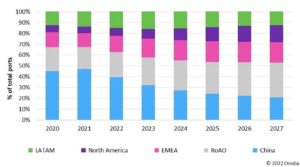
PON Access Equipment Revenue Forecast by Region/Country (2020-2027)
The rest of Asia and Oceania will grow significantly at a CAGR of 21.8% between 2020 and 2027. Many ISPs in this large area are upgrading to 10G PON, while others such as those in India are building FTTH networks with GPON. Several ISPs in the region have already expressed interest in using 25G GPON for 5G small cell xHaul transmission.
the EMEA region is another region to see growth, which is expected to grow at a CAGR of 11.1% between 2020 and 2027. To a certain extent, it reflects the construction and upgrade of PON networks by traditional telecommunication operators and cable operators. Alternative operators have also emerged in Western Europe, some of which are building networks to lease to retailers. The strong growth in the EMEA region was also driven by the construction of new networks in several countries in Africa.
In North America, the construction and upgrade of PON networks are growing among various types of network operators, some of which are more vocal than others. The region will grow at a CAGR of 24.0% during the forecast period. Public funding will support network expansion and the entry of new operators.
Several countries in Latin America and the Caribbean are investing in PON networks, especially in the Mexican and Brazilian markets. The region is expected to grow at a CAGR of 7.1%. Some cable operators in the region are abandoning DOCSIS 4.0 in favor of PON-centric networks.
Table of Contents
ToggleRelated Products:
-
 EPON-OLT-PX20+ EPON OLT SFP TX-1.25G/RX-1.25G TX-1490nm/RX-1310nm PX20+ 20km SC SMF DDM Transceiver Modules
$25.00
EPON-OLT-PX20+ EPON OLT SFP TX-1.25G/RX-1.25G TX-1490nm/RX-1310nm PX20+ 20km SC SMF DDM Transceiver Modules
$25.00
-
 NOKIA 3FE53441BAAA Compatible GPON OLT SFP TX-2.5G/RX-1.25G TX-1490nm/RX-1310nm Class C+ 20km SC SMF DDM Transceiver Modules
$35.00
NOKIA 3FE53441BAAA Compatible GPON OLT SFP TX-2.5G/RX-1.25G TX-1490nm/RX-1310nm Class C+ 20km SC SMF DDM Transceiver Modules
$35.00
-
 Ubiquiti UF-GP-C+ Compatible GPON OLT SFP TX-2.5G/RX-1.25G TX-1490nm/RX-1310nm Class C+ 20km SC SMF DDM Transceiver Modules
$30.00
Ubiquiti UF-GP-C+ Compatible GPON OLT SFP TX-2.5G/RX-1.25G TX-1490nm/RX-1310nm Class C+ 20km SC SMF DDM Transceiver Modules
$30.00
-
 Huawei GPON-OLT-CLASS C+ Compatible GPON OLT SFP TX-2.5G/RX-1.25G TX-1490nm/RX-1310nm Class C+ 20km SC SMF DDM Transceiver Modules
$32.00
Huawei GPON-OLT-CLASS C+ Compatible GPON OLT SFP TX-2.5G/RX-1.25G TX-1490nm/RX-1310nm Class C+ 20km SC SMF DDM Transceiver Modules
$32.00
-
 Dasan Zhone MXK-GPON-SFP-C+-RSSI Compatible GPON OLT SFP TX-2.5G/RX-1.25G TX-1490nm/RX-1310nm Class C+ 20km SC SMF DDM Transceiver Modules
$30.00
Dasan Zhone MXK-GPON-SFP-C+-RSSI Compatible GPON OLT SFP TX-2.5G/RX-1.25G TX-1490nm/RX-1310nm Class C+ 20km SC SMF DDM Transceiver Modules
$30.00
-
 XGSPON-ONU-C XGSPON ONU SFP+ TX-9.95G/RX-9.95G TX-1270nm/RX-1577nm N1/N2 SC DDM 0°C~70°C Optical Transceivers
$75.00
XGSPON-ONU-C XGSPON ONU SFP+ TX-9.95G/RX-9.95G TX-1270nm/RX-1577nm N1/N2 SC DDM 0°C~70°C Optical Transceivers
$75.00

